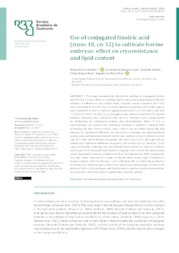Use of conjugated linoleic acid (trans 10, cis 12) to cultivate bovine embryos: effect on cryoresistance and lipid content.
Use of conjugated linoleic acid (trans 10, cis 12) to cultivate bovine embryos: effect on cryoresistance and lipid content.
Author(s): CARVALHO, B. P.; COSTA, F. de Q.; DETONI, D.; ROSA, F. B.; DIAS, A. J. B.
Summary: This study evaluated the effect of the addition of conjugated linoleic acid (CLA) to in vitro culture on viability, lipid content, and cryoresistance of bovine embryos at different in vitro culture times. Cumulus oocyte complexes (N = 974) were maturated in vitro for 22 h. In vitro fecundation ensued for 18 h. Viable zygotes were cultivated in vitro in medium supplemented with CLA (100 mM) in the first 72 h (CLA-F), last 72 h (CLA-L), or throughout the culture period (CLA-T). Control embryos (control) were cultivated with no CLA. Embryos were cryopreserved by vitrification for subsequent analysis after devitrification. Effect of CLA on cryoresistance was assessed by cultivating embryos in synthetic oviductal fluid containing 5% fetal bovine serum. Lipid content was quantified using Nile Red staining. No significant difference was observed in cleavage rate, blastocyst:total oocyte ratio, and blastocyst:cleaved oocyte ratio. Culture in CLA-L reduced survival rate 24 h after devitrification compared with CLA-F and CLA-T, although with no statistically significant difference compared with control group. However, CLA-T improved embryo hatching rate and affected lipid content of embryos. Cultures CLA-F and CLA-L increased lipid content compared with control. Yet, lipid content values decreased in embryos treated with CLA-T, but they did not differ significantly from the values observed for oocytes at the germinal vesicle stage. Treatment of bovine embryos with CLA during in vitro cultivation did not affect the production of blastocysts, reducing lipid content and improving cryoresistance. However, the effects of CLA on cryoresistance and lipid content is significant only when embryos are exposed to the compound throughout the cultivation period.
Publication year: 2019
Types of publication: Journal article
Unit: Embrapa Acre
Keywords: Animal reproduction, Bovino, Cattle, Cold tolerance, Congelamento, Conjugated linoleic acid, Contenido de lípidos, Criopreservación, Criopreservação, Cryopreservation, Cultivo de embriones, Cultura In Vitro, Embrião Animal, Embrión (animal), Embryo (animal), Embryo culture, Ganado bovino, Lipid content, Lipídio, Oocyte vitrification, Polyunsaturated fatty acids, Reproducción de animales, Reprodução Animal, Resistência a Temperatura, Tolerancia al frío, Vitrificación de ovocitos, Ácido graxo poliinsaturado, Ácido linoleíco conjugado, Ácidos grasos polisaturados
Observation
Some of Embrapa's publications are published as ePub files. To read them, use or download one of the following free software options to your computer or mobile device. Android: Google Play Books; IOS: iBooks; Windows and Linux: Calibre.
Access other publications
Access the Agricultural Research Database (BDPA) to consult Embrapa's full library collection and records.
Visit Embrapa Bookstore to purchase books and other publications sold by Embrapa.

